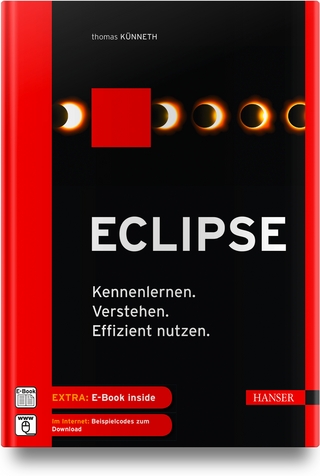
Eclipse Modeling Project
Addison-Wesley Educational Publishers Inc (Verlag)
978-0-321-53407-1 (ISBN)
- Titel ist leider vergriffen;
keine Neuauflage - Artikel merken
Domain-specific languages (DSLs) and model-driven development (MDD) offer software engineers powerful new ways to improve productivity, enhance quality, and insulate systems from rapid technological change. Now, there’s a pragmatic, start-to-finish guide to creating DSLs and using MDD techniques with the powerful open source Eclipse platform. In Eclipse Modeling Project, Richard C. Gronback illuminates both the principles and techniques software professionals need to master, offering insights that will be invaluable to developers working with any tool or platform.
As coleader of the Eclipse Modeling Project, Gronback is singularly well-positioned to demonstrate DSLs and MDD at work in Eclipse. Gronback systematically introduces each of the Eclipse technologies that can be used in DSL and MDD development. Throughout, he introduces key concepts and technologies in the context of a complete worked example and presents new best practices and never-before published techniques. He also covers Eclipse projects discussed in no other book, including Query/View/Transformation (QVT) and the Graphical Modeling Framework (GMF)–a project the author personally leads.
Eclipse Modeling Project gives software practitioners all the knowledge they need to explore the remarkable potential of DSLs and MDD–and includes coverage of
Why a model-based approach enables the rapid customization of high-quality solutions within the product line paradigm
How the Eclipse Modeling Project’s capabilities can be used to efficiently create new DSLs
Powerful techniques for developing DSL abstract syntax, graphical notation, and textual syntax
How to build Model-to-Model (M2M) and Model-to-Text (M2T) transformations–including a powerful new M2M implementation of the Object Management Group’s QVT Operational Mapping Language (OML)
Efficiently packaging and deploying DSLs with Eclipse
Complete reference sections for the Graphical Editing Framework (GEF), GMF runtime and tooling, QVT OML, Xpand, and more
Foreword xix
Preface xxi
Acknowledgments xxiii
About the Author xxv
Part I: Introduction 1
Chapter 1: Introduction 3
Chapter 2: Modeling Project as a DSL Toolkit 17
Part II: Developing Domain-Specific Languages 27
Chapter 3: Developing a DSL Abstract Syntax 29
Chapter 4: Developing a DSL Graphical Notation 55
Chapter 5: Developing a DSL Textual Syntax 227
Chapter 6: Developing Model-to-Model Transformations 231
Chapter 7: Developing Model-to-Text Transformations 277
Chapter 8: DSL Packaging and Deployment 303
Part III: Reference 315
Chapter 9: Graphical Editing Framework 317
Chapter 10: Graphical Modeling Framework Runtime 353
Chapter 11: Graphical Modeling Framework Tooling 503
Chapter 12: Graphical Modeling Framework FAQs 545
Chapter 13: Query/View/Transformation Operational Mapping Language 549
Chapter 14: Xpand Template Language 605
Part IV: Appendixes 651
Appendix A: Graphical Modeling Framework Key Bindings 653
Appendix B: Model-Driven Architecture at Eclipse 661
References 671
Richard Gronback is the chief scientist for modeling products at Borland Software Corporation, where he manages both open source and commercial product development. Richard represents Borland on the Eclipse Board of Directors and Planning and Architecture Councils, co-leads the Modeling project Project Management Committee (PMC), and leads the GMF and Amalgam projects. Richard holds a Bachelor of Software Engineering degree in computer science and engineering from the University of Connecticut. He was a reactor operator in the U.S. Navy before entering his current career in software.
Foreword xix
Preface xxi
Acknowledgments xxiii
About the Author xxv
Part I: Introduction 1
Chapter 1: Introduction 3
Chapter 2: Modeling Project as a DSL Toolkit 17
Part II: Developing Domain-Specific Languages 27
Chapter 3: Developing a DSL Abstract Syntax 29
Chapter 4: Developing a DSL Graphical Notation 55
Chapter 5: Developing a DSL Textual Syntax 227
Chapter 6: Developing Model-to-Model Transformations 231
Chapter 7: Developing Model-to-Text Transformations 277
Chapter 8: DSL Packaging and Deployment 303
Part III: Reference 315
Chapter 9: Graphical Editing Framework 317
Chapter 10: Graphical Modeling Framework Runtime 353
Chapter 11: Graphical Modeling Framework Tooling 503
Chapter 12: Graphical Modeling Framework FAQs 545
Chapter 13: Query/View/Transformation Operational Mapping Language 549
Chapter 14: Xpand Template Language 605
Part IV: Appendixes 651
Appendix A: Graphical Modeling Framework Key Bindings 653
Appendix B: Model-Driven Architecture at Eclipse 661
References 671
| Erscheint lt. Verlag | 2.4.2009 |
|---|---|
| Reihe/Serie | the eclipse series |
| Verlagsort | New Jersey |
| Sprache | englisch |
| Maße | 180 x 235 mm |
| Gewicht | 1040 g |
| Themenwelt | Informatik ► Programmiersprachen / -werkzeuge ► Eclipse |
| Mathematik / Informatik ► Informatik ► Web / Internet | |
| ISBN-10 | 0-321-53407-7 / 0321534077 |
| ISBN-13 | 978-0-321-53407-1 / 9780321534071 |
| Zustand | Neuware |
| Haben Sie eine Frage zum Produkt? |
aus dem Bereich

